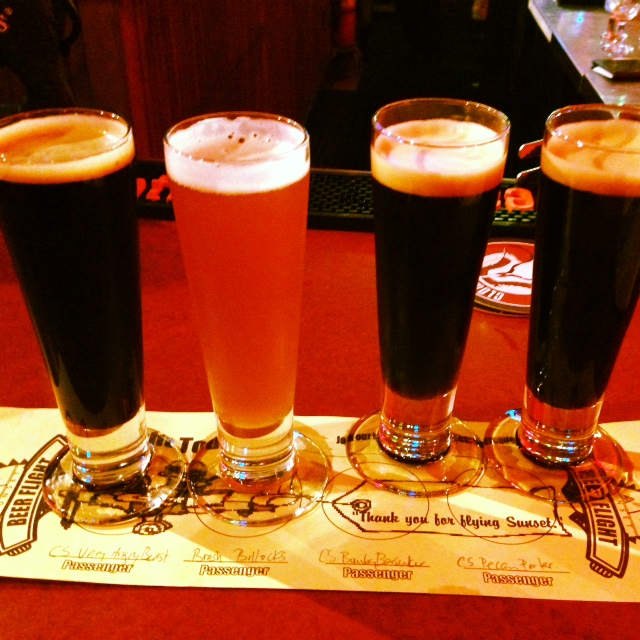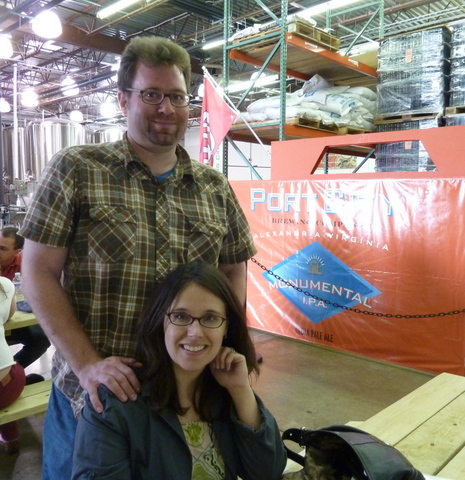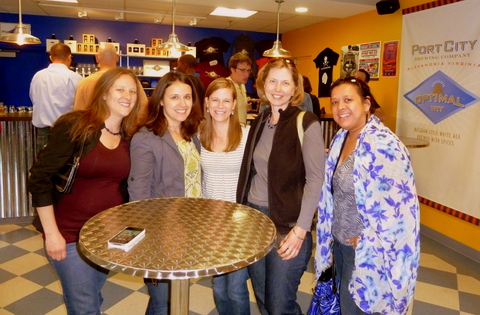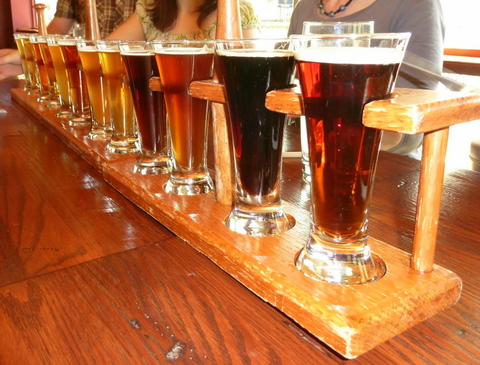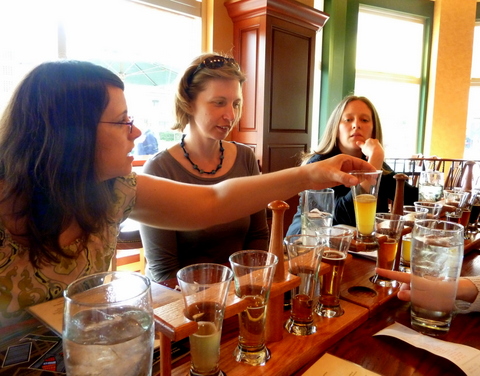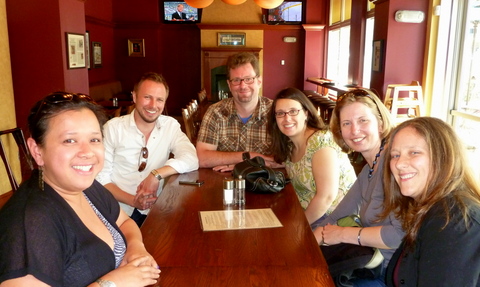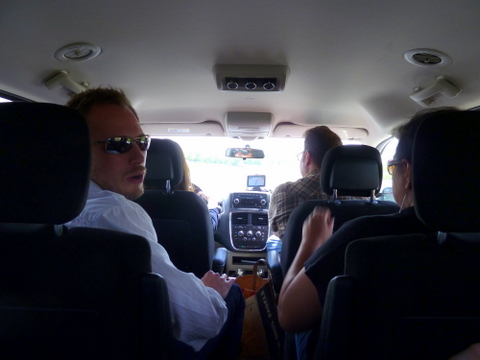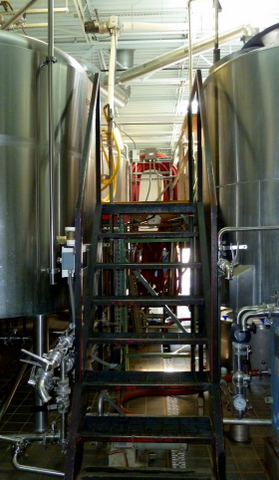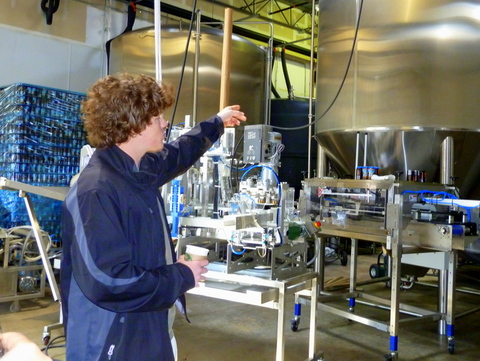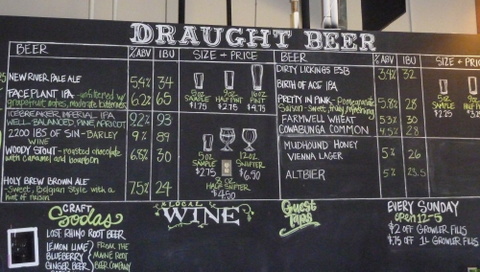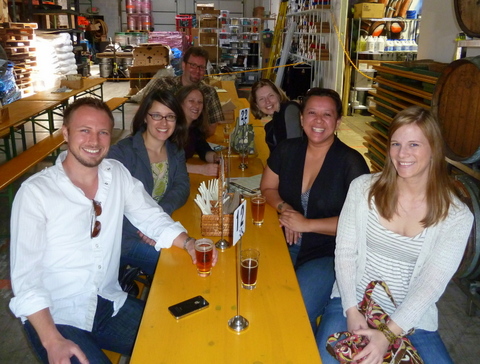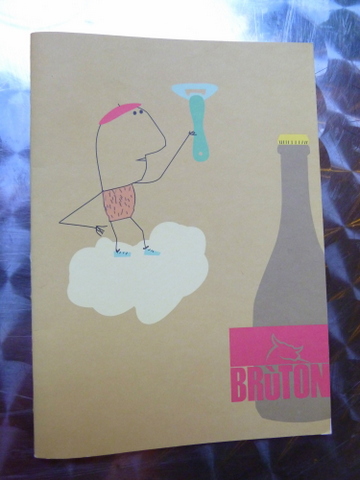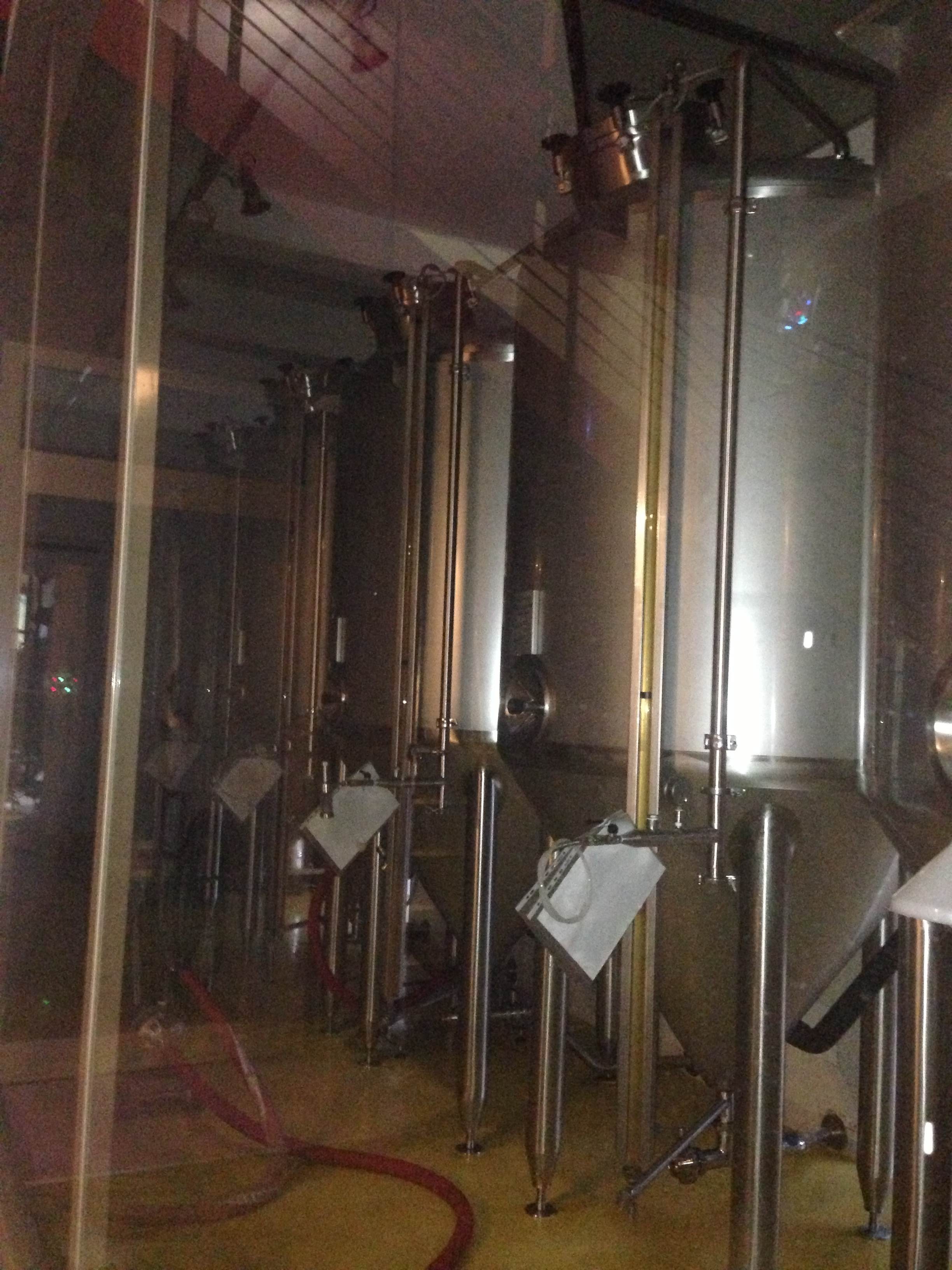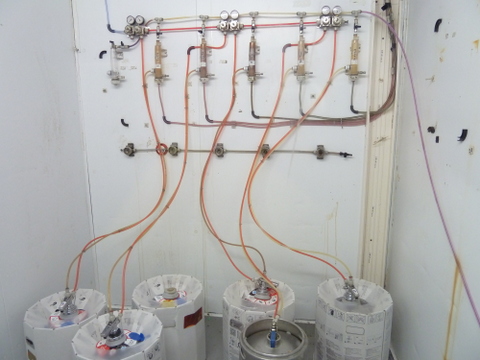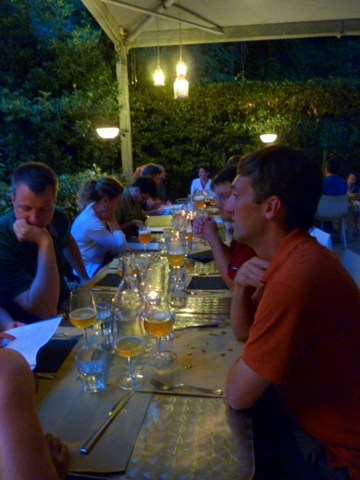I couldn’t help but notice that the Alcohol and Tobacco Tax and Trade Bureau, which regulates breweries new and old in this country, is one of many government agencies facing furloughs. According to the U.S. Treasury Department’s website, only 35 of 483 employees will continue to work, until Congress does its work. Those 35 employees are those “necessary to perform activities necessarily implied by law” and those “necessary for protection of life and property.” Notably, those 35 employees are not ones who participate in “processing of permits, [and] certificates of label approval.” Thus, the upshot of the government shutdown for the beer industry is that the government won’t be issuing any new permits for new breweries. It also means that there will be no new certificates issued for new beers or new imports. Amendments to current licenses will also be restricted, so any brewery with expansion plans will be stalled for the time being. Thus, for now, beer lovers can buy only existing beers on the market, provided their labels haven’t changed … a serious limitation for experimental types. Interestingly, “processing of tax returns” and “maintaining minimum staff necessary to perform accounting functions” are considered “necessary for the safety of human life or protection of property.” Therefore, the agency will continue to collect money from the beer industry, without providing any of the services that allow breweries to begin, maintain, or grow their businesses. In the face of these obstacles imposed by the government shutdown, breweries seem to be maintaining their collaborative spirit, at least with furloughed (“nonessential”) government employees: Flying Dog Brewery in Frederick, MD is offering free tours for furloughed government employees. I like to imagine that the
employees from the TTB may be eligible for further beer-oriented benefits.
Very Angry Beast, most delightful table companion
Last week, Clown Shoes and Brash Brewing teamed up for a tap takeover at Sunset Grill and Tap in Allston. With Sunset featuring over 100 taps and almost four times as many bottles, Clown Shoes and Brash faced heavy competition, but they still managed to win the night. Clown Shoes offered fifteen different brews, from their light, summery Clementine White Ale, to their Swagger Hoppy Red Lager, to some very serious stouts. Brash, recently exiled from its home state of Texas due to the state’s three tier alcohol distribution laws, and brewing again alongside Clown Shoes in Ipswich, brought five different beers, including its Cold Ass Honky Hoppy Saison and Texas Exile Imperial Oatmeal Coffee Stout.
Luckily, the Craft Beer Crew made the journey to Sunset to help the Allston regulars make their way through the Clown Shoes and Brash kegs. Highly seasoned amateurs, the Craft Beer Crew understood that there’s not much choice when faced with such a tap takeover other than to indulge in a beer flight. Joining the fray, I ordered three Clown Shoes beers – the Very Angry Beast, the Bombay Berserker Indian Chai Stout, and the Pecan Pie Porter – and one Brash beer – the Bollocks Double IPA
As its kind is wont to do, the Very Angry Beast made me quite happy, with its up-front assault on the taste buds and a complex follow-through of different flavors. Clown Shoes brands this Beast as an American Double Imperial Stout, but there’s more to it than that. What hits you first is the woody, vanilla flavor imparted by the Four Roses Bourbon barrels that aged this brew. Then, it offers deep chocolate and espresso undertones, supported by a solid, roasted malt backbone. The 11.5% ABV of this brew is apparent in its aroma and taste. Clown Shoes made only five kegs of this Very Best beer of the night.
The Bombay Berserker is also styled as an American Double Imperial Stout, but it falls on the chai side of beers, if such a side exists. Indeed, it smells and tastes of chai tea, cardamom, ginger and cinnamon… but it comes in stout form. I was not as enthusiastic about this combination, but it cultivated a solid following that night. The Pecan Pie Porter is Clown Shoes’ Fall seasonal beer, with the reasoning that “everyone else does pumpkin beers.” While I didn’t perceive much pecan pie taste, it is a noticeably nutty porter, with a slightly buttery taste that plays well with the roasted malt notes.
My second favorite beer was Brash’s Bollocks. Brash accurately notes: “At 12% ABV and 110 IBUs, it’s the liquid equivalent of Lenny in John Steinbeck’s Of Mice and Men. Gently tending rabbits then suddenly … snap, it’s a whirlwind of crazy.” There’s nothing I like more than a whirlwind of crazy (aside from a Very Angry Beast), and Bollocks did not disappoint. The focus of the aroma is citrus-y fruit, malt, and booze. There’s a solid background of bitterness to the taste, but on top of it floats hops in the guise of citrus and pine, sweet caramel malts, and alcohol heat. For me, this DIPA was definitely an attention-grabber, and its complexity did not distract, but instead contributed to its deliciousness.
Small breweries are experimenting more and more with different beer styles. Keep an eye out for style debuts and tap takeovers at your local establishments – your taste buds will thank you.
Advice from a yeast wrangler: “If it smells horrible and looks horrible, just don’t taste it.”
Type “yeast wrangling” or “yeast ranching” into the Google search bar and you’ll discover a growing trend in both commercial and home brewing: a focus on exploiting yeast for all of its worth, which is increasing by the petridish.
A handful of commercial breweries are currently known for their experimentation with yeast, along with bacteria. For example, Mystic Brewery has cultivated its Renaud strain of yeast, which is featured in its saison beers. Similarly, Mystic’s wine, Vinland One, was fermented with an indigenous strain of yeast called Winnisimmet, sourced from a Massachusetts-grown plum. Oxbow Brewery in Newcastle, Maine, also experiments with innovative ingredients, combining grains like rye and spelt with various strains of yeast and bacteria. For example, it creates beers like the sour ale called Arboreal, which it ferments and ages in bourbon barrels with Brettanomyces and Lactobacillus, along with its Sasuga Saison, a rice ale that the brewers ferment with brettanomyes and saison yeast. Oxbow’s Freestyle series of beer was created to indulge just this sort of experimentation with new combinations of ingredients.
However, much of the experimentation with yeast occurs on a smaller scale, in homebrewing communities and in yeast wranglers’ makeshift laboratories. One self-proclaimed yeast rancher, a Ph.D. student in cell biology, isolates yeasts by drinking bottles of Belgian beers, pouring out the yeast from the dregs, and growing the colonies in petridishes. In his Brooklyn, NY apartment, he keeps his equipment, including beakers, test tubes, flasks, a hood, a microscope, and an incubator. Once his colonies are complete, he inoculates a small amount of yeast into low-specific-gravity wort and offers it to brewers over the internet under the name BKYeast.
Another participant in this yeast trend is an open source yeast project called Bootleg Biology. The goal of this project is to “create the most diverse library of microbes for the creation of alcoholic and fermented beverages.” As a rule, microbes for this project are sourced and isolated only from “bootleg” sources including contributors’ backyards, honey, yogurt, fruit, and bottle dregs. The project’s website describes a DIY method for a contributor to capture and isolate his or her own strain of yeast at home. Briefly, a would-be yeast wrangler can create a homebrew starter with water and malt, boil with hops, and pour into sterilized mason jars sealed with cheesecloth and a rubber band. The jars are left outside overnight, retrieved, and then left in a dark, room temperature space. After about two weeks, the starter will be ready to smell and taste – with caution and good judgment, of course – in order to select the most promising candidates to transfer to agar plates and isolate the yeast. Bootleg Biology’s founder, Jeff Mello, originally used a similar method to capture and isolate S. arlingtonesis from a lambic starter in his Arlington, VA backyard.
Both BKYeast and Bootleg Biology were recently featured in Beer Advocate magazine. Other blogs and communities that discuss yeast wrangling include the DC Yeast Lab, Sui Generis, Cowtown Yeast Wranglers, and Eureka Brewing. The next time you taste that spicy, earthy, or barnyard-like nuance of yeast in a beer, you might consult one of these resources to determine just which microbe is responsible for that flavor!
Grey Sails inspire local brewing, local giving
Named for the grey sails that can be seen on the horizon from any New England beach, Grey Sail Brewing of Rhode Island set up shop in a former macaroni factory in April 2011. After a post WWII hiatus during which the United States Post Office and later a retailer occupied the space, owners Alan and Jennifer Brinton brought grain back to the building to brew their first batch of beer on 11/11/11.
Grey Sail’s Flagship beer is a cream ale made with noble hops. Available on draft and in cans, it pours a hazy golden color and comes in doughy and with a touch of sweetness through the nose. The taste follows through with malty, sweet and creamy notes, creating a session beer easy on the palate. The Flagship Ale took the gold medal for cream ales at the 16th Annual Great International Beer & Cider Competition in Providence last fall.
Flying Jenny, an unfiltered extra pale ale, is Grey Sail’s other year-round offering. Head brewer Josh Letourneau incorporates five different malts and northwestern hops to create a balanced, highly drinkable beer. Flying Jenny pours amber in color, smells of grapefruit citrus with tropical notes, and tastes of citrus with floral hop bitterness, balanced by a bready, caramel malt backbone. Grey Sail’s seasonal beers include Hazy Day, a Belgian Wit; Autumn Winds, an Oktoberfest; and Leaning Chimney, a Smoked Porter.
Grey Sail takes pride in contributing to its community in addition to brewing award-winning beers. It created a special brew called Bring Back the Beach Blonde to support the Greater Westerly-Pawcatuck Area Chamber of Commerce. Available locally, proceeds were donated to the Chamber Foundation to help the 27 small businesses that were devastated by Hurricane Sandy in October 2012. Sales of the limited edition beer also contributed to the effort to put sand back on local beaches – to ensure that future beach-goers will have a soft place to sit to watch for those grey sails on the horizon.
Brew at the Zoo – two brand spankin’ new local breweries
I managed to find a few local breweries that I did not know at Brew at the Zoo this weekend – score! Down the Road Brewery and Percival Beer Company were founded or launched in 2013 and promise to add new local flavor to current Boston-area offerings.
Donovan Bailey founded Down The Road Brewery this year, with the goal to “balance between history, tradition and innovation.” The Brewery, currently located in Newton Highlands, is currently raising funding to procure new digs with a 3 barrel brewing capacity. Down the Road hopes to be up and running, complete with a tasting room, in 6 months.
Bailey uses his 20 years of brewing experience to emulate and improve traditional ale and lager styles of beer, studying historical brewing techniques whenever he creates a new beer. He currently offers four beers, all over 11% ABV. T-34 is named after the WWII Russian T-34 tank. A classic Russian Imperial Stout, it is dark, rich and smooth, featuring tastes of malt, chocolate, coffee, and dried fruit. Wayne’s Wee Heavy is crafted applying traditional techniques to traditional ingredients, resulting in a malty Scottish ale with notes of chocolate, toffee, and dried fruits. Hopheads will take pleasure in trying Quadrupled, the Hop Monster. Bailey dry hops this beer four times and keeps the malt profile to a minimum, resulting in a piney, citrusy, very dry double imperial IPA. A Belgian Quadruple Ale named Angel’s Breath rounds out Down the Road’s beer selection. Typical of Belgian ales, its nose is all banana and cloves, but once it hits the tongue, the taster is rewarded with a rounded maltiness, and notes of dried fruits and dark chocolate.
Percival Beer Company (PBC) is an independent craft beer micro-brewer and distributor. Felipe Oliveira, a 36-year-old Milton resident who grew up in Dorchester, founded the brewery in 2011 and officially launched the brand early this year. PBC is currently seeking a main office and distribution warehouse in Dorchester (Dot), a diverse community known in recent decades for “dilapidated homes, vacant store fronts and unsafe streets.” However, the brewery recognizes the more recent “invigorating spirit of innovation and positivity sweeping the neighborhood,” and has announced its mission “to promote localization and inspire the Dorchester community to reinvent and innovate.”
The brewery takes pride in brewing light and simple craft beer that is not intimidating to commercial beer drinkers but still tasty to craft beer drinkers. The Kompadre Lager, an homage to a Cape Verdean word that describes the bond developed amongst family and friends, is a crisp lager with a strong hop aftertaste. The Dot Ale 360 – a light pale ale – pours amber in color and offers a balanced hop profile. There are rumors of an IPA in the making, but it appears that Dorchester and beyond will have to wait to taste!
For all of you Bostonians, there are new tastes to experience! Go find them!
What’s Russian about an Imperial Stout?
The story of how Russia became associated with the Imperial Stout reads simultaneously as historical nonfiction, gossip column, and questionable speculation. Some of the first stories of how the British developed the Russian Imperial Stout resemble the history of the IPA, with the stout’s high gravity and high alcohol content acting as a preservative and anti-freeze agent for the journey to Russian consumers.
However, little reliable evidence has been identified to support the theory. Instead, beer historians who have studied the marketing of this stout have found simply that the Russians – and its favorite Czars – preferred dark, thick, high alcohol content beer. For example, a widely quoted passage from The History and Antiquities of the Parish of St. Saviour, Southwark discusses Henry Thrale, owner of Anchor Brewery in Soutwark and famous exporter of the stout, stating, “Thrale’s Entire [a contemporary name for porter] is well known, as a delicious beverage, from the frozen regions of Russia to the burning sands of Bengal and Sumatra. The Empress of All Russia is indeed so partial to Porter that she has ordered repeatedly very large quantities for her own drinking and that of her court.” Commentators have suggested that a focus on the flamboyant Catherine the Great may have been a very effective marketing technique.
The Russians seemed to have liked British porters so much that they were excluded from the March 31, 1822 tariff introduced by the Russian government, which banned just about every other article of British manufacture. Historians speculate that Russians desired the continuation of that one particular export because they were not particularly talented at making it themselves.
The importance of the stout to the Russians is also supported by stories of a Belgian named Le Coq, who exported stout from Britain to the Baltic region during the period when Napoleon’s forces dominated Baltic ports. Le Coq was awarded the Imperial warrant for his export business and generous donations of the stout to Russian soldiers wounded in the Crimean War. Le Coq began to brew Imperial stout in Russia after an early 20th century increase in Russian import duties, but the business was nationalized by the Bolsheviks shortly after the 1917 Russian revolution. Le Coq’s family would wait over 50 years to see any compensation by the government.
The beer that the Catherine and her Russians loved was bottle-fermented with live yeast, so that it could be left on a shelf to improve with age. It was brewed from pale, amber and black malts, along with small doses of Pilsner malt. The beer was aggressively hopped with Target hops, and poured at 10% alcohol by volume. It offered notes of leather, licorice, chocolate, dark fruit and bitter hops. Characteristic of the style, the mouthfeel was thick and oily. Most Russian Imperial Stouts today reflect these features of the well-traveled Russian Imperial Stout.
A Bostonian’s Path Less Traveled: NoVa Brewtopia (Part III – Port City)
Having whetted our malt beverage appetites at Lost Rhino Brewing Company and Mad Fox Brewing Company, our grad school gaggle found Port City Brewing Company, in my one-time home of Alexandria, VA, to be hopping. The Brewery’s name commemorates Alexandria’s historical role as an important colonial seaport, and later brewing hub, once home to the Robert Portner Brewing Company. Founded in 1866, the Portner Brewery was the largest brewery in the southern U.S. up until Prohibition. Port City achieved recent fame with its release and re-release of Derecho Common beer, an accidental but fortuitous result of the 2012 Derecho storm that knocked out power to most of the DC area.
When we arrived, groups of beer drinkers lined the Port City tasting room, and spilled into the picnic tables in the brewing warehouse. A few of us ambitiously arranged for a full tasting of beers on tap. Starting again on the light side, I breezed through the crisp, easy-drinking Downright Bohemian Pilsner and moved right on to the Essential Pale Ale. An American Pale Ale made from American hops and English and German malts, it offered a fruity, slightly bitter taste and finished smoothly. The Monumental IPA, named for, yes, D.C.’s many monuments, poured a bright amber color from the tap. The brewers add American hops during the brewing and fermentation processes, so the floral, bitter hop taste – reminiscent of orange peel – hit pretty hard, and it was only somewhat balanced by some background caramel malty notes.
My favorites were the Tartan and the Oyster Stout. The Tartan is a tribute to the 80-shilling style beer of Scotland in the 1800s. Looking very much its part as a Scottish beer, the Tartan was deep amber in color and featured a rich roast caramel flavor, with very little hop bitterness. Port City produced only a 90 barrel batch of the Tartan as its spring seasonal. The Revival Stout, brewed in the British and Irish traditions of oyster stouts, does indeed call for oysters in its recipe. Port City steeps War Shore Oyster Company’s Chesapeake Bay oyster shells in the brewing water, and also adds oysters into the brew during the boil. I didn’t taste much of the sea in the brew, but it did have a slightly salty, very smooth character, with notes of roast and chocolate. Five percent of the sales of Revival Stout are donated to the Oyster Recovery Partnership’s efforts to revive the oyster population in the Chesapeake Bay.
Our three brewery NoVA tour complete, we clamored back into the minivan for our last stop: dinner at the Bier Baron Tavern near Dupont Circle in D.C. Now filled with beer and getting hungry, all that was left to do was turn the minivan music up, dance in the confines of our seat belts, and plot which of 500 beers we were about to enjoy with dinner.
A Bostonian’s Path Less Traveled: NoVa Brewtopia (Part II – Mad Fox)
With one brewery under our belts, the grad school gaggle strode confidently from our minivan into the Mad Fox Brewing Company in Falls Church, VA. The Mad Fox styles itself as a Euro gastro brewpub, and like the Lost Rhino, sources its food from local farms and butchers, as well as the Falls Church Farmer’s Market. Its beers, which span German, English, Belgian and American traditions, are all brewed on-site. When you enter the establishment, you immediately encounter 15-barrel stainless steel serving tanks, standing more than ten feet tall behind the host stand.
Our group took over a hightop table near the bar and decided that the best strategy to take advantage of the extensive array of beer offerings was to order three 4-beer samplers. Since our samplers arrived so thoughtfully arranged from light to dark, and since we were no longer taking the path less traveled at Lost Rhino, I made the executive decision to taste in traditional fashion, beginning with beers we could see through and ending with the darker, more mysterious, brooding concoctions. I read out descriptions from the very detailed Mad Fox beverage menu and passed around the glasses.
One of the first tastes at the light end was a Mad Fox signature beer, the German style Kölsch. The Kölsch incorporates German noble Hersbrucker hops, which add piney notes to the flavor, with German malts to balance out the subtle hop bitterness. The Kölsch yeast keeps the beer crisp and light. Further down the row of glasses stood Lindy’s Weiss, a Bavarian Style Hefeweizen, heavy on the German malts and light on the hops. A very traditional Hefeweizen, the taster is treated to heavy flavors of bananas produced by the yeast that ferments the beer. Closing in on the mid-point of the sampler beckoned the Broad Street IPA (weighing in at 7.3% ABV), a single hop IPA, brewed with Centennial Hops and then also dry-hopped with almost 50 pounds of Centennial Hops, producing an herbal and citrus aroma that is transformed into hoppy bitterness upon taste.
After 7 tastes, I was amazed that the group still paid attention, or pretended to pay attention, to the very helpful descriptions I was reading from the menu. The scientific method in our hearts, we plodded on. My favorite turned out to be the Leonidas – Batch 300 Ale. English and German malts provided a sufficiently solid malt backbone to balance out the kettle additions of 100% Citra hops and the dry hopping with more Citra and other Simcoe-type hops. The citrus of the hops and sweet smoothness of the malt, with a slight alcohol finish, resulted in my ordering an entire glass of it once the sampling was finished. (DC-ers: I just read that the rest of the batch was barrel aged and released in June, so get to Mad Fox and drink some for me!)
Last in the tasting was a porter and an imperial stout, both very good. Big Chimney’s Porter, an English-style robust Porter, is brewed with English malts that create a dark color with reddish highlights, in addition to the roast and chocolate flavors. English hops add just a touch of bitterness. The Crazy Ivan Russian Imperial Stout is also brewed with English malts, along with roasted barley and flaked oats, but incorporates heavier hopping than its porter cousin. The result was a very big, complex, flavorful stout.
Our sampling complete, urbanites, suburbanites, PhDs, neuroscientists and social scientists alike chose their favorite beers to finish off. At some point, a visionary had the presence of mind to order a pretzel and delicious frickles from the food menu to line our stomachs for the last brewery of the day, Port City Brewery. Before I knew it, I was sandwiched in that back middle seat again headed toward my high school stomping grounds of Alexandria, VA. Somewhat subdued by the latest round of beers and food, the natives in the back of the minivan felt sufficiently satisfied to sway with traffic, catch air on the worst bumps in the road, and jeer quietly about “mom’s” driving. (to be continued…)
A Bostonian’s Path Less Traveled: NoVa Brewtopia (Part 1 – Lost Rhino)
It wasn’t our original plan, but the 7 of us ended up renting a 7-seat minivan for our NoVa (that’s Northern Virginia, for you New Englanders) beer tour. And it wasn’t my original plan, but I sat in the middle of the 3-seat back row the entire trip. What did we have in common? Attending some sort of graduate school, and beer. Anyone who has survived grad school will advise focusing on the beer. To avoid my own education-induced version of PTSD, (yet again) I will do just that.
First, the suburbanites abandoned the safe confines of Silver Spring (home of the FDA) to lure those in DC (home of the Michael Jackson house) from their urban utopia. The minivan now complete, I sat sandwiched between two PhDs on my way to the Lost Rhino in Ashburn, VA. It was a mellow, temperate Saturday morning in Virginia, and we kids in the back required little regulation from “mom and dad” (actually, newlyweds) up front.
After my own heart, the brewers at Lost Rhino believe in “inspiring excursions” and “taking the path less traveled” (“it’s a tasty one”). Creations including Holy Brew Brown, Helles and Back, and Final Glide Hefeweizen suggest just what sort of life experiences motivate these brewers. The tour guide certainly took the path less traveled, tracing the history of beer all the way back to Mesopotamia, delving deep into the science of gravity, and (cue spacey-sounding music) expounding on the many possible, and not at all possible, origins of the name Lost Rhino.
Our scientists’ brains full, but our glasses empty, the minivan contingent grew restless. My Pretty in Pink – a brisk pomegranate saison, with notes of hibiscus, spice, and a slight sour funk, created by four women from four breweries in honor of Breast Cancer Awareness month – had disappeared around Mesopotamia, so I eagerly plotted my tasting strategy while the tour guide explained the final steps of bottling.
At long last, we retired to the tasting room, for lunch and for the implementation of my carefully planned tasting strategy. The food menu complementing this casual, family-friendly space features fresh ingredients from local vendors, from artisanal cheeses to potato chips to sausages, providing endless pairing opportunities with the brewery’s beverages. Ever focusing on the beer, my tasting strategy began where most finish (on the dark, heavy end) with the Woody Stout, offering an aroma of spicy chocolate and coffee, balancing the caramel and vanilla flavors created by aging in Bourbon oak barrels. Hints of molasses and brown sugar added complexity. It was not the biggest, fullest stout I’ve ever tasted, but would likely be a good introduction to the style for lighter beer drinkers.
Next, I watched as smooth, hazy It’s Not My Falt Altbier flowed from the tap to my glass. The nose hit with sweet, roasted malt, and caramel notes, and it tasted of chocolate, with a light, spicy finish. It was around the time I ordered my next beer, Holy Brew Honey Blonde, that my tasting strategy succumbed to the temptations of group tasting: sharing. My Blonde was light with hints of honey wheat; the Faceplant IPA, an unfiltered amber ale dominated by Cascade and Centennial hop flavors, offered a floral nose but resisted the classic bitter IPA finish despite multiple hop additions during the brewing process; the New River Pale Ale featured a balance of sweet and bitter flavors, with two types of malts and 4 types of hops, hitting the tongue with pine, citrus and fruit flavors.
A group favorite was the Holy Brew Brown, a sweet brown ale brewed with Pilsner and Caramel malts and Candi Sugar, a traditional Belgian brewing ingredient used to increase alcohol content without adding extra body to the beer. This Brown was malty with a touch of spice, and quite effervescent and crisp for a dark beer. Dried-fruity notes gave way to a slightly alcohol finish.
Now fortified and quite familiar with the Lost Rhino tasting menu, we crammed back into our minivan chariot. The animal behaviorist PhD having escaped to the middle row, I now sat between two social scientists. Mysteriously, the atmosphere of the minivan shifted as its occupants became more boisterous. “Mom and dad” began to yell at us from the front seats (“stop kicking each other!”), but nonetheless got dragged into our heated argument over the merits of the survival of pandas as a species, given their lackadaisical attitudes toward sex (and general ineptness at it). Throughout the lively discussion, mom faithfully kept the minivan pointed toward Falls Church, VA, home of Mad Fox Brewing Company… (to be continued)
La verità è nella biera
The Tuscan sun has surrendered to a warm July evening, and you are strolling down a pleasant road in Ponte a Moriano with a merry band of 14 fellow Villa dwellers. You are all merry because you have identified the sole craft brewery within kilometers, and it happens to be a mere 3 km from your Villa. The blue dot (you) is steadily closing in on the red dot (brewery) on your GoogleMap App. All is well in the world.
You are so content that you actually bump into the lead stroller when he halts, quite abruptly. It appears that Google Maps did not reveal the minor detail that the last .6 km of the trip is a highway. The merry band reconsiders, retreats, but then retrenches. The highway is a terrifying Italian one with little Fiats and Renaults, accompanied by rather large freight trucks, zipping by at alarming speeds, mercilessly honking at 15 (haphazardly) merry beer seekers. But soon, the blue dot is on top of the red dot and you are in what you have come to imagine as Shangri-La: Bruton Brewery.
The brewery is named for the beer that the Minoans on Crete would offer to the minotaur that was locked within the labyrinth of the Palace of Knossos. Its ales are unfiltered and unpasteurized, and the brewers incorporate a re-fermentation process once the brew is bottled to increase the complexity and the longevity of the beer. Upon entering the brewery, you can see the sparkling kegs and keglines that are serving the taps upstairs through a small window, and the fermenters are proudly displayed through a larger window.
Out back there is a lovely oasis of a beer garden and a full menu to accompany your beer tasting.
Bruton Brewery offers a wheat beer (Bianca), a blonde ale (Bruton di Bruton), a strong golden ale (Stoner), a bitter (interestingly, Lilith), a dubbel (Momus), a barley wine (10), and a Christmas seasonal (St. Renna). My favorite was (interestingly) the bitter, inspired by the classic American pale ale. It incorporates Cascade hops that create a citrus taste, but the beer is balanced by caramel flavors and bitter notes at the end. The strong golden ale was tasty as well, with a nose of apricot and dried fruit. The flavor combines hops, honey, and malts, along with the higher alcohol finish.
After a long meal and many pitchers of beer, it is time for the merry band to return to the Villa. The highway is now darker and more terrifying, but the group, now fortified and (for better or worse) encouraged, is ready to meet it. Fast time is made on this Italian night, and you marvel as your head hits the pillow at your luck – at finding great beer in this Tuscan countryside, and at dodging certain death as a pedestrian on a dark Italian highway.
To watch a YouTube video of the head brewer talking about the brewery, whose mom kindly drove certain merry Villa dwellers from the Pisa airport to town, please click here.

